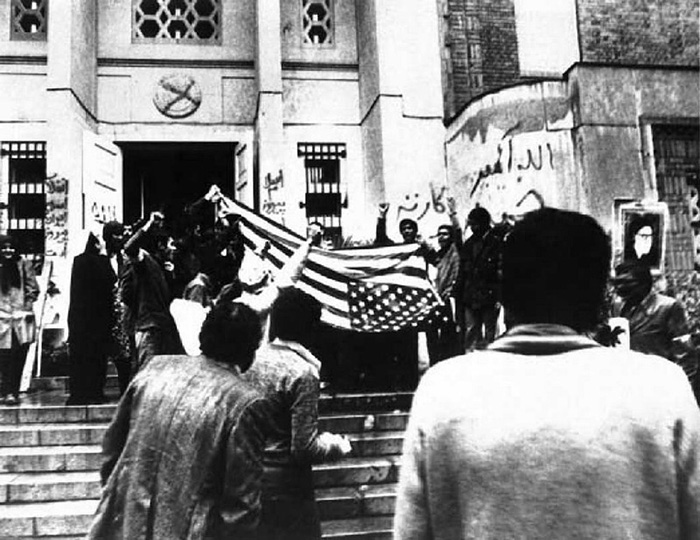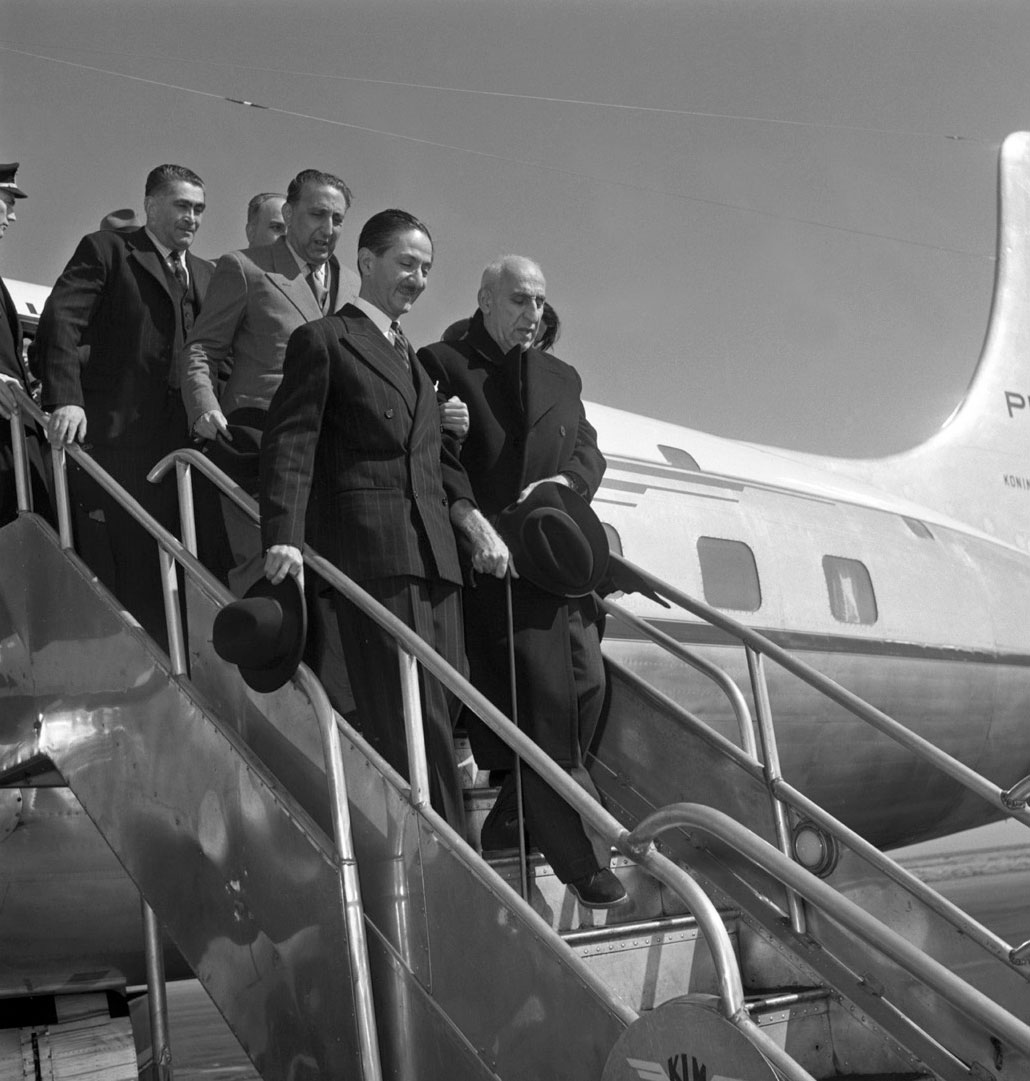A Lingering Poison—Tehran, 40 Years Later: What Have We Learned?
Events of four decades ago continue to cast their malevolent shadows over a relationship that should have long since become more productive.
BY JOHN LIMBERT

Iranian students storm the U.S. embassy in Tehran on Nov. 4, 1979.
Wikimedia Commons
On Nov. 4, 1979, a chilly, wet Sunday in Tehran, a group of Iranian engineering students calling themselves “Moslem Student Followers of the Imam’s Path” stormed and occupied the American embassy compound on Taleghani (formerly Takht-e-Jamshid) Avenue. Planned as a 48-hour protest against U.S. policy, their action turned into an international melodrama that has for 40 years poisoned American-Iranian relations in ways few could have foreseen at the time.
Since that fateful day, the United States and Iran have been stuck in an endless downward spiral of futility. The two countries glare at each other across an abyss and trade accusations, insults and threats. A war of words sometimes escalates into violence, although the two sides have so far mostly avoided direct conflict. Attempts by either side to break the spiral have crashed on the rocks of third countries’ interests, toxic domestic politics, deep mistrust and bad timing.
One constant of these dysfunctional relations is that whenever there is promise of change, bad luck or a dumb decision sets everyone back into familiar patterns of unthinking hostility and chest-beating. For example, whatever its limitations, the 2015 agreement on restricting Iran’s nuclear program (the Joint Comprehensive Plan of Action) represented a different way of doing things. It demonstrated that long-neglected tools of diplomacy—consultation, patience and listening—could accomplish more for both sides than decades of repeating empty slogans and insults.
Then, in 2016, something unforeseen occurred. As in Monty Python’s world, where “no one expects the Spanish Inquisition,” no one expected the election of a President Donald J. Trump obsessed with undoing the work of his predecessor, hiring anti-Iranian zealots as advisers and presenting himself as the world’s greatest negotiator. But the unexpected happened, and so events of 40 years ago continue to cast their malevolent shadows over a relationship that should have long since become something more productive. Most recently, we have seen a “locked and loaded” administration— already suffering from low credibility—determined to blame Iran immediately for the September attack on Saudi Arabia’s oil facilities without bothering to present evidence.
What happened?
One constant of these dysfunctional relations is that whenever there is promise of change, bad luck or a dumb decision sets everyone back into familiar patterns of unthinking hostility and chest-beating.
The Iranian Setting: Ideologues Ascendant
Most Iranians welcomed the fall of the Pahlavi monarchy in February 1979, if only to end the violence that had torn the country apart for more than a year. But the change brought Iranians neither order nor the promised paradise. Members of the diverse coalition that brought down Shah Mohammad Reza Pahlavi, the last king of Iran, were soon at each other’s throats. Hard-line Islamists, Maoists and everyone in between battled in the media, in the schools and in the streets. Ethnic separatists threatened to seize control in Arabic-speaking areas. The government maintained a measure of authority in the Kurdish areas only because Marxist and anti-Marxist Kurds hated each other more than they did Tehran.
A provisional government led by Mehdi Bazargan and his religious-nationalist allies was supposed to run affairs until a constitutional assembly could finish its work and establish the new Islamic Republic’s permanent government. But Bazargan and his colleagues never had a chance. By the fall of 1979, they had lost authority to an informal “state within a state,” run by an alliance of senior clergy linked to Ayatollah Mohammad Beheshti and his Islamic Republican Party. In the provincial towns, Friday prayer leaders overshadowed governors; in offices “Imam’s (i.e., Khomeini’s) representatives” overshadowed titular chiefs; and in neighborhoods local komitehs (revolutionary committees), answerable to powerful clerics and able to arrest anyone for any reason, overshadowed what was left of the police.
In this confusion, moderates, nationalists and liberals were squeezed between radicals of left and right. Extremists on both sides were well organized, armed and unconcerned with democratic niceties. While some wrote penetrating articles, others used clubs, chains and acid to make their points. When Islamist goon squads attacked liberal papers and demonstrations, the leftists, including the Mojahedine- Khalq (MEK), cheered them on.
Strong in the media, schools and universities, the leftists found a powerful message: anti-Americanism. They argued that America was using its agents in Iran to undermine the revolution, and that the new authorities had not gone far enough in purging the remnants of feudalism, capitalism and American influence. They attacked clerics for being “soft on America” and members of the provisional government for taking orders from the U.S. embassy. When a Tehran komiteh arrested MEK member M.R. Sa’adati in May 1979 on charges of spying for the Soviets, the leftist media launched a tirade of vitriol against Foreign Minister Ebrahim Yazdi, claiming that he had ordered Sa’adati’s arrest on American instructions.

Iranian students climb over the gate of the U.S. embassy in Tehran, Nov. 4, 1979.
Wikimedia Commons
The American Setting: Mission Impossible
In 1979 officials of the Jimmy Carter administration struggled with two questions: What had happened in Iran, and what do we do now? The first led to the ever-popular Washington game of finding a scapegoat. Historians, journalists and former officials—both Iranian and American— continue their arguments on this subject to the present day.
As for the second question, no one knew the answer. In 1979 the Cold War “prime directive” of Washington’s Iran policy— resist communist expansion—remained in force despite the upheavals in Tehran. “We have a common enemy to your north,” Carter’s National Security Adviser Zbigniew Brzezinski told Bazargan’s provisional government. Thus, the Cold War gave U.S. Embassy Tehran its mission: maintain a relationship with whoever rules Iran, which remains important for its oil and location, as a customer of American goods (including military equipment) and—above all—as a barrier, whether as monarchy or theocracy, to Soviet ambitions.
The United States could not remain untouched by Iran’s post-revolution strife. Maintaining anything like a normal relationship was going to be very difficult, and would require more agility and good luck than was available. Islamists and leftists were beating their anti-American drums, amplified by state radio and television under the leadership of the quixotic Sadeq Qotbzadeh (a former Georgetown student). Neither group was interested in anything approaching normality, which they equated with betrayal. In October 1979 Secretary of State Cyrus Vance encountered this reality at the United Nations when his question to his Iranian counterpart— “Where can our two countries go from here?”—elicited only a recital of grievances.
The final straw was the fate of the deposed shah and his desire to come to the United States. In July 1979 Chief of Mission Bruce Laingen advised Secretary of State Vance that admitting the shah while Iran remained unsettled would have the following results:
• The moderate provisional government would fall.
• Any chance of a U.S.-Iran relationship would vanish.
• There would be no American embassy in Tehran.
Members of the diverse coalition that brought down Shah Mohammad Reza Pahlavi, the last king of Iran, were soon at each other’s throats.
Until October 1979 President Carter and Secretary Vance had resisted calls to admit the shah. That month the president learned—apparently for the first time—that the shah was sick with cancer in Mexico and needed to come to the United States for urgent treatment. The shah’s illness led Vance to change his position; and Carter, isolated among his staff, reluctantly agreed. According to Chief of Staff Hamilton Jordan’s account, the president asked his advisers: “Tell me one thing. What are you going to advise me to do when our embassy is overrun and our people taken hostage?” Jordan did not record any answers.
In Tehran, we at the embassy learned of the president’s decision on Oct. 20. The message to us was clear: “You are expendable. Good luck.” Never was there any mention of total or partial evacuation of embassy staff. Someone apparently believed that the United States could have it all: admit the shah, keep an embassy in Tehran and continue to resist Soviet expansion.
Iranian Plans: Who Is the Enemy?
In all this fog a group of engineering students from five Tehran schools met to decide how to show their dissatisfaction with the course of events. According to (later) accounts of their leaders, the group believed they needed to take some anti-American action and began planning a brief occupation of the American embassy. Two of the original five—including a future president of Iran, Mahmoud Ahmadinejad—disagreed with the plan and proposed attacking the Soviet embassy, which, in their view, was supporting the Iranian leftists—the most serious threat to the revolution. The others objected, claiming that America was giving shelter to the deposed shah and plotting his return in a rerun of the 1953 coup, and was thus the greater danger. Ahmadinejad and his ally left the group, although later, as president from 2005 to 2013, he would bring former hostage-takers into his cabinet.
Recent research has revealed that these students also feared that their leftist rivals would outflank them with their loud anti-American rhetoric. If the Islamists took no action, they would be vulnerable to charges of being “pro-American” and would find themselves isolated and weakened in the ongoing domestic power struggles. By attacking the American embassy, they could seize the anti-American mantle, preempt the leftists and proclaim: “Others talk. We act.”
Events unfolded precisely as President Carter and COM Laingen had foreseen. When the students attacked the embassy, the nominal Iranian authorities could do nothing. Urgent calls to officials of the provisional government met only questions about visas. The Marine Security Guards had orders not to fire on the attackers; thanks to these young men’s training and discipline, we avoided a bloodbath.
Someone apparently believed that the United States could have it all: admit the shah, keep an embassy in Tehran and continue to resist Soviet expansion.
Ayatollah Khomeini may have been unhappy with the students’ action, but he would not end it. Presented with a fait accompli and an apparent surge of support in the streets, he decided to ride this wave rather than stand against it. He understood how to use the occupation to cement control of the new state by his closest allies, clerical ideologues sharing his harsh vision of Iran’s future. He endorsed the occupation, calling it “a second revolution, greater than the first” and used it to purge nationalists, moderates and, eventually, leftists from the revolutionary coalition. Iran’s provisional government, now exposed as powerless, collapsed. Anyone who would answer American phone calls could do nothing; those who could do something were not taking calls.
All these calculations meant that we at the embassy were in for a long detention as we waited for the adults in the room to intervene. Those adults never appeared, however; and our hours in captivity became days, weeks and months. Khomeini relished his role as “defier-in-chief,” rejecting appeals from dozens of international figures. The more obstinate he was, the more popular he became, earning the title aashti naapazir (implacable).
Some of our captors have since claimed that they never intended events to unfold as they did, but that they were used and caught in the role of long-term prison guards and pawns in Iran’s raucous political chess game. They became like the dog that caught the bus. They had captured the embassy and its people. Now what should they do? One of them told me bluntly: “All this is not about you. It’s not about the shah. It’s not about the United States. We have scores to settle with our Iranian enemies, and you are crucial to our doing so.” How does one answer that? One sits and waits.
Lessons Learned … and Ignored

Former Iranian Prime Minister Mohammad Mossadegh (front right). The democratically elected prime minister was removed from power on Aug. 19, 1953, in a coup supported and funded by the British and U.S. governments. He was imprisoned for three years and then put under house arrest until his death in 1957.
AFP / Getty Images
It is certain there are lessons to be learned from these events. It is less certain anyone has learned them.
Respect the power of history and ghosts. Powerful ghosts of repeated humiliations have troubled Iran’s relations with the outside world for more than 200 years. These indignities long predate any U.S.-Iranian interaction. They include the unequal treaties of Gulistan (1813) and Turkmanchai (1828), the larcenous D’Arcy oil concession of 1901, the cynical Anglo- Russian agreement of 1907 and the Allied occupation of Iran during World War II.
More recent humiliations did involve the United States. They include the CIA coup of 1953, the status of forces agreement of 1964, the appointment of the head of the Central Intelligence Agency as U.S. ambassador to Iran in 1973 and the death of 300 civilians in the destruction of an Iranian airliner in 1988.
When President Carter agreed to let the shah come to the United States, he ignored history and the ghosts of 1953, when Washington had helped topple a nationalist prime minister and returned the shah from abroad. In October 1979 our orders in Tehran were to “inform the Iranian government that the shah’s admission was based on purely humanitarian grounds and had no political motive.” We did our best. But, given the history, what Iranian over the age of 3 would believe such a statement—even if it were true?
Expect the unexpected and avoid the easy assumption. We fell into a trap of our own making when we made assumptions about likely Iranian reactions to admitting the shah. President Carter ignored his own misgivings. His administration ignored clear reports from its diplomats in Tehran and media stories about the prevailing anarchy there and the growing power of extremists. It misread the situation of Iran’s provisional government and its ability to control events. It assumed the clerical authorities, particularly Ayatollah Khomeini, would calculate their interests in a certain way. It never considered that those with power in Iran would encourage and exploit anarchy rather than control it.
The irony is that events of 1978—the uprisings that led to the shah’s downfall—should have taught us to question all assumptions. A few weeks before the first of those uprisings, President Carter was in Tehran toasting the shah as a beloved leader of a country he called “an island of stability in a troubled region.” A year later the shah was gone, and the island of stability was in chaos. Obviously, we learned nothing from those unexpected events, when the leader of a strong, prosperous and friendly country could be toppled so easily by unarmed crowds loyal to an aging, exiled theocrat. In 1979 we repeated our failure of 1978 when we declined to look closely at reality and instead continued to believe what we wished to be true. Perhaps in both cases reality was too unpleasant to consider.
Make noise, and be a pain in the ass. This is hard. We are a disciplined, polite and collegial Service; but we still owe the country our best (and often unwelcome) judgments. We are not sent overseas to participate in groupthink and to remain silent when ill-considered decisions put lives in danger.
Khomeini understood how to use the occupation to cement control of the new state by his closest allies, clerical ideologues sharing his harsh vision of Iran’s future.
In Tehran 40 years ago we survived only by good fortune. A more violent Iranian group could have attacked the embassy; a Marine Security Guard could have panicked and opened fire; we could have faced an uncontrolled mob of 100,000; the rescue mission sent in April 1980 might have reached the embassy, with unpredictable consequences. (As it were, that mission cost the lives of eight American airmen and Marines in the central desert.)
It could have been much worse, as my cautionary tale of the diplomacy and power politics surrounding the Treaty of Turkmanchai in 19th-century Iran indicates (October 2017 FSJ). The Iranians’ attack on the Russian embassy in 1829, in response to a harsh and unwelcome Russian dictat and perceived threats to Iranian honor, resulted in the death of the ambassador and his staff when the Cossack guards panicked and opened fire on the crowd.
Being obnoxious may be the only way to get attention, although doing so goes against all the values of our Service. In hindsight, when it was clear in October 1979 that the American administration was going to admit the shah despite the best advice of its own people, our response at the embassy should have been: “Fine. You have ignored our advice and left us exposed. Tehran is in chaos, and the so-called government has no power to protect us. Now we are ordering an evacuation. To hell with your Cold War calculations.” Instead, those of us “experts” who supposedly understood conditions in Tehran sat quietly waiting for the ax to fall. There was a failure less of leadership than of “followership.” By our silence we betrayed ourselves and our colleagues.
What began as a 1970s-style student sit-in (with a few handguns to back it up) soon became a full-scale international crisis that would eventually destroy the Carter presidency and make it almost impossible for the United States and Iran to reach anything resembling a normal relationship. On the American side, officials continue to sermonize about Iran’s “malign behavior” and dismiss questioning voices as delusional. On the Iranian side, the mindless chanting of empty slogans continues, and the authorities commemorate Nov. 4, 1979, as a victory and pretend that the embassy seizure was an act to be proud of. They will not admit, despite all evidence, that it was a shameful action that did enormous harm to Iran and its people.




